UMass Extension's Landscape Message is an educational newsletter intended to inform and guide Massachusetts land care professionals in the management of our collective landscape. Detailed reports from scouts and Extension specialists on growing conditions, pest activity, and cultural practices for the management of woody ornamentals, trees, and turf are regular features. The following issue has been updated to provide timely management information and the latest regional news and environmental data.
Welcome to Landscape Message #16 for the 2024 growing season. We are now in the bi-weekly phase of the annual schedule, and the next message will be posted on Friday, September 6. To receive immediate notification when the next Landscape Message update is posted, be sure to join our e-mail list
Click on the headings below to jump to that section of the message.
In This Issue
Scouting Information by Region
Woody Ornamentals
Scouting Information by Region
Environmental Data
The following data was collected on or about August 21, 2024. Total accumulated growing degree days (GDD) represent the heating units above a 50ºF baseline temperature collected via regional NEWA stations (http://newa.cornell.edu) for the 2024 calendar year. This information is intended for use as a guide for monitoring the developmental stages of pests in your location and planning management strategies accordingly.
|
MA Region/Location |
2024 Growing Degree Days |
Soil Temp |
Precipitation |
Time/Date of Readings |
||
| Gain since last report |
2024 total |
Sun |
Shade |
|||
|
CAPE |
269 |
1998 |
73 |
68 |
0.63 |
12:00 PM 8/21/2024 |
|
SOUTHEAST |
289 |
2266 |
76 |
68 |
2.26 |
3:00 PM 8/21/2024 |
|
NORTH SHORE |
263 |
2063 |
66 |
61 |
1.74 |
10:00 AM 8/21/2024 |
|
EAST |
268 |
2263 |
73 |
67 |
1.35 |
4:00 PM 8/21/2024 |
|
METRO |
250 |
2135 |
61 |
59 |
2.62 |
6:30AM 8/21/2024 |
|
CENTRAL |
255 |
2165 |
68 |
62 |
3.84 |
9:30 AM 8/21/2024 |
|
PIONEER VALLEY |
258 |
2207 |
73 |
67 |
2.96 |
2:00 PM 8/20/2024 |
|
BERKSHIRES |
222 |
1924 |
68 |
60 |
3.20 |
6:45AM 8/21/2024 |
|
AVERAGE |
259 |
2128 |
70 |
64 |
2.33 |
|
|
n/a = information not available |
||||||
US Drought Monitor: At this time, just a small section of of northeastern Middlesex county and the northern 1/3 of Essex county are classified as "D0 - Abnormally Dry" (about 3% of the state's area in total). State map as of Thursday 8/22: https://droughtmonitor.unl.edu/CurrentMap/StateDroughtMonitor.aspx?MA
Phenology
| Indicator Plants - Stages of Flowering (BEGIN, BEGIN/FULL, FULL, FULL/END, END) | ||||||||
|---|---|---|---|---|---|---|---|---|
| PLANT NAME (Botanic / Common) | CAPE | S.E. | N.S. | EAST | METRO W. | CENT. | P.V. | BERK. |
|
Clematis terniflora (sweet autumn clematis) |
Begin |
Begin |
Begin |
Begin |
Begin |
Begin |
Full |
* |
|
Fallopia japonica (syn. Polygonum cuspidatum) (Japanese knotweed) |
Begin/Full |
Full |
Full |
Begin |
Full/End |
Full |
Full |
Full |
|
Clethra alnifolia (summersweet clethra) |
Full/End |
Full/End |
Full/End |
Full/End |
Full/End |
Full/End |
End |
Full/End |
|
Hibiscus syriacus (rose-of-Sharon) |
Full/End |
End |
Full/End |
Full/End |
Full/End |
Full/End |
End |
Full |
| * = no activity to report/information not available | ||||||||
Regional Notes
Cape Cod Region (Barnstable)
General Conditions:
The average temperature for the period from Aug 7 – Aug 21 was 69ºF with a high of 85ºF on Aug 10 and a low of 52ºF on Aug 21. Temperatures have been primarily in the 70s with lows around 60ºF. Short cloudy stretches have been dispersed among longer stretches of mostly sunny days. Precipitation occurred on several days during the period, primarily from showers. Precipitation amounts tend to vary across the region, and just over half an inch fell in Barnstable, MA. Soil moisture is short.
Herbaceous plants seen in bloom during the period include cardinal flower (Lobelia cardinalis), black eyed Susan (Rudbeckia hirta), purple Joe-Pye weed (Eutrochium purpureum), flowering onion (Allium ‘Millenium’), and hardy hibiscus (Hibiscus moscheutos). Woody plants seen in bloom include sourwood (Oxydendrum arboreum), hydrangea (H. macrophylla & H. paniculata), mimosa (Albizia julibrissin), and Franklinia (Franklinia alatamaha).
Pests/ Problems:





 Beware of box tree moth, and please scout boxwood regularly. Box tree moth damage can happen fast, therefore weekly scouting is advised.
Beware of box tree moth, and please scout boxwood regularly. Box tree moth damage can happen fast, therefore weekly scouting is advised.
Insects or insect damage observed during the period include turpentine beetle and pine tip moth damage on pitch pine, chilli thrips damage to big leaf hydrangea, euonymus scale on Japanese holly, sycamore lace bug damage on sycamore, two spotted spider mites on various herbaceous and woody plants, tuliptree spot gall on tuliptree, oleander aphids on milkweed, hibiscus sawfly damage on hibiscus, sunflower moth damage on purple coneflower, and some lingering Japanese beetles feeding on rose-of-Sharon. The chorus of katydids and crickets is strong at night.
Disease symptoms or signs observed during the period include powdery mildew on numerous hosts, beech leaf disease on beech, cercospora leaf spot on bigleaf hydrangea, hydrangea rust on smooth hydrangea, gray leaf spot on Japanese forest grass, venturia leaf spot on poplar, cedar apple rust on crabapple, pear trellis rust on Bradford pear, septoria leaf spot on Rudbeckia, foliar nematode on hosta and astrantia, guignardia leaf spot on horsechestnut, and leaf spot on black locust. Summer lawn diseases have been very active during the period.
Other issues observed in the landscape include scorch on dogwoods, rabbit damage to annuals and perennials, deer browse of hosta, and slug and snail damage to perennials.
Weeds seen in bloom during the period include carpetweed (Mollugo verticillata), spotted spurge (Euphorbia maculata), redroot pigweed (Amaranthus retroflexus), tansy ragwort (Jacobaea vulgaris), and yellow wood sorrel (Oxalis stricta).
Southeast Region (Dighton)
General Conditions:
The weather over the past two weeks has remained warm and humid with occasional thunderstorms, though it has been noticeably more moderate compared to the intense tropical heat of July. Since Tuesday, August 6th, the highest temperature was 86ºF at midday on Saturday, August 10th, while a low of 59ºF was observed on the mornings of Thursday, August 8th, Monday, August 12th, and Tuesday, August 13th. It rained steadily on Friday, August 9th, with lighter showers on Tuesday, August 13th, and Sunday, August 18th, totaling 2.26 inches. The average temperature during the period was approximately 73ºF, with an average humidity of 85%. The highest wind speed was 19 mph from the south-southwest on August 9th. On Wednesday, August 21st, at 3:00 PM, the soil temperature measured 76ºF in full sun and 68ºF in shade.
Plants currently in flower include Buddleia davidii (butterfly bush), Campsis radicans (trumpet vine), Clematis paniculata (sweet autumn clematis), Clethra alnifolia (summersweet clethra), Hibiscus syriacus (rose-of-Sharon), Hydrangea paniculata (panicle hydrangea), Koelreuteria paniculata (goldenrain tree), Lythrum salicaria (loosestrife), Polygonum cuspidatum (Japanese knotweed), and Sophora japonica (Japanese pagoda tree).
Pests/Problems:
State officials have confirmed the first human case of Eastern Equine Encephalitis (EEE) this year in Plymouth County. Given Massachusetts' history with EEE and current environmental conditions that favor mosquito activity, county mosquito control projects are on high alert. To reduce the risk, aerial spraying for mosquitoes is being conducted in specific areas of Bristol and Plymouth Counties. Outdoor workers are strongly advised to take preventive measures, such as using insect repellent, wearing protective clothing, and avoiding outdoor work during peak mosquito hours, particularly from dusk to dawn.
North Shore (Beverly)
General Conditions:
Day temperatures on most of the days during this two-week reporting period were mostly in the low 70s to mid 80s, and nighttime temperatures were mostly in the low 50s to mid 60s. The average daily temperature was 69ºF with the maximum temperature of 87ºF recorded on August 10 and the minimum temperature of 53ºF recorded on August 8. Approximately 1.74 inches of rainfall was recorded at Long Hill during the last two weeks. Due to moist soil, turf on lawns is green and fresh. There has been no need for watering garden plants or irrigating lawns in most areas in the region during this period.
Woody plants seen in bloom include panicle Hydrangea (Hydrangea paniculata), butterfly bush (Buddleia davidii), rose-of-Sharon (Hibiscus syriacus), and summersweet clethra (Clethra alnifolia). Herbaceous plants seen in bloom include garden phlox (Phlox paniculata), allium 'Globemaster' (Allium spp.), bee balm (Monarda didyma), Joe-Pye weed (Eupatorium purpureum), hardy geranium or cranesbill (Geranium spp.), black-eyed Susan (Rudbeckia hirta), coneflower (Echinacea purpurea), hardy begonia (Begonia grandis), heliotrope (Heliotropium arborescens), and an assortment of annual flowers.
Pests/Problems:
Magnolia scale was observed on saucer Magnolia (Magnolia soulangeana). If magnolia scale is limited to a few branches, it’s possible to prune out infested twigs. Otherwise, use a registered pesticide labelled for use on magnolia scale. Multiple treatments may be needed to fully eliminate heavy infestations.
Powdery mildew continues to be observed on lilac, bee balm and garden phlox. Leaves on heavily infected lilacs are starting to turn chlorotic and drop. Some dogwood trees are also heavily infected with powdery mildew.
Weeds continue to thrive in landscapes. Some of the weeds observed in bloom include white clover (Trifolium repens), yellow woodsorrel (Oxalis stricta), purslane (Portulaca oleracea), spotted spurge (Euphorbia maculata), bittersweet nightshade (Solanum dulcamara), Japanese knotweed (Polygonum cuspidatum), and pigweed (Amaranthus retroflexus). Ticks and mosquitoes continue to be very active. Always protect yourself when working or walking outdoors in the woods.
East (Boston)
General Conditions:
We have had a couple of weeks that have felt more like mid-September than mid-August. Daytime temperatures averaged 78ºF with a high of 86ºF on the 10th. Overnight lows averaged 61ºF with a low of 55ºF on the 8th. We had three minor rain events spread out over the two week period totaling 1.35 inches of precipitation. This rainfall combined with the moderate temperatures has provided good growing conditions for landscape plants.
Perennial borders continue to flower and are busy with pollinator activity.
Pests/Problems:
Viburnum leaf beetle adults (Pyrrhalta viburni) continue to defoliate susceptible viburnums.
Common mugwort (Artemisia vulgaris) and pokeweed (Phytolacca americana) are flowering and producing seed along unmanaged roadsides.
Metro West (Acton)
General Conditions:
The summer season is winding down. The length of daylight is shortening daily by the minute; plants are heavy with fruit, seeds, berries, and nuts; and temperatures are cooling off. The high and low temperatures recorded for this 2-week reporting period were 87ºF on the 10th and 53ºF on the 20th. On Friday the 23rd, the daytime length was at 13 hours and 34 minutes with sunrise at 6:01am and sunset at 7:35pm. To illustrate my point, the daytime length, just four days prior, on Monday the 19th was at 13 hours and 44 minutes with sunrise at 5:57am and sunset at 7:41pm.
The historical monthly average rainfall for the month of August is 3.72”. During this past two-week reporting period, 3.28” of rain was recorded. Needless to write, at this time, soils are well saturated and ready for planting.
Observed in some stage of bloom at this time were the following plants: Boltonia asteroides (Bolton’s aster), Clematis terniflora (sweet autumn clematis), Eutrochium purpureum (Joe-Pye weed), Franklinia alatamaha (Franklin tree), and Sedum ‘Rosy Glow’ (stonecrop).
Pests/Problems:
Wind gusts measuring up to 34 mph with 0.61” of rain in the late afternoon on the 15th caused much downed leaf and branch debris. In nearby communities, whole trees succumbed to the wind and rain.
Powdery mildew is visible on Cornus florida (dogwood), Hamamelis (witchhazel), Monarda spp. (bee balm), Paeonia spp. (peony), and Syringa vulgaris (lilac).
Central Region (Boylston)
General Conditions:
With temperatures slowly coming down and prior flowers gone to seed or fruit, we continue to see another dose of late summer blooms. With temperatures averaging 77.7ºF (highest being 85.8ºF on August 10th), nights have dropped as low as 56ºF F on the 20th, and even potentially dropping as low as 53.4ºF F on the 21st. Max precipitation was 1.0 inch on the 15th, averaging 3.84 inches in the almost 2-week span.
Some plants that can be seen blooming currently are panicle hydrangea (Hydrangea paniculata), evening primrose (Oenothera biennis), jewelweed (Impatiens capensis), pink turtlehead (Chelone lyonii), great lobelia (Lobelia siphilitica), cardinal flower (Lobelia cardinalis), mountain mint (Pycnanthemum spp), rose mallow hibiscus (Hibiscus moscheutos), Joe-Pye weed (Eutrochium spp), and goldenrod (Solidago spp.).
Pests/Problems:
With the occasional thunderstorms, high winds have caused a lot of tree damage and fallen branches. Pooling water and damp weather have also brought an uptick in mosquitos; West Nile virus has been confirmed in central Massachusetts and treatments have been conducted.
Some pests/problems that are continually seen in the landscape are varieties of foliar rust and powdery mildew.
Purple loosestrife (Lythrum salicaria) continues to flower along roadsides and fields.
Pioneer Valley (Amherst)
General Conditions:
As we round out the final days of August, it’s been another strong growing season in the Pioneer Valley. The sheer volume of vegetation produced annually across forests and the managed landscape is truly impressive. Two major rain events bookended this reporting period with combined accumulations ranging from 3–5” across the tri-counties. Soil moisture remains high as it has for most of the summer and conditions remain ideal for transplanting certain woody plants. Temperatures have taken a nosedive at the time of writing (high temps near 70ºF with lows near 50ºF on 8/20 to 8/22), but the long-term forecast calls for a return to more seasonable temperatures.
By late summer, the landscape is no longer looking its best. While some plants still appear quite vigorous, others are showing the rigors of a very hot and humid summer. As such, it’s easy to encounter plants with scattered twig and branch dieback, premature leaf shedding, and a general chlorotic appearance. As mentioned previously, crabapples and apples (Malus) are nearly devoid of foliage due to apple scab and other foliar pathogens. Many sugar maples (Acer saccharum) have been observed with pale green to yellow canopies. Leaf reddening is developing on certain plants, especially Viburnum, due to the changing sun angle and an increase in the production of anthocyanins to prevent sunburn as chlorophyll production wanes.
Pests/Problems:
 Feeding injury from the elm zigzag sawfly (Aproceros leucopoda) has been observed on several Princeton elms (Ulmus americana ‘Princeton’) on the UMass campus. This non-native insect pest, which originates from parts of China and Japan, is capable of severe defoliation when populations are high. Widespread planting of DED-resistant American elms has occurred on campus in recent years, including a long allée of Valley Forge elms (U. americana ‘Valley Forge’). Currently, the symptoms are nuanced, and the damage is very minor (see photo). However, it seems that the early stages of infestation will be challenging to detect in many cases. Elms should be carefully scouted for evidence of the serpentine (or zigzag) pattern of feeding so that management efforts can be targeted in the future.
Feeding injury from the elm zigzag sawfly (Aproceros leucopoda) has been observed on several Princeton elms (Ulmus americana ‘Princeton’) on the UMass campus. This non-native insect pest, which originates from parts of China and Japan, is capable of severe defoliation when populations are high. Widespread planting of DED-resistant American elms has occurred on campus in recent years, including a long allée of Valley Forge elms (U. americana ‘Valley Forge’). Currently, the symptoms are nuanced, and the damage is very minor (see photo). However, it seems that the early stages of infestation will be challenging to detect in many cases. Elms should be carefully scouted for evidence of the serpentine (or zigzag) pattern of feeding so that management efforts can be targeted in the future.
The combined effects of Tubakia leaf blotch (Tubakia spp.) and oak anthracnose (Apiognomonia errabunda) has some oak canopies looking brown and ragged. Annual and perennial mushrooms and conks of wood-rotting fungal pathogens continue to appear on or near the base of infected trees. Document the number of fruiting bodies and their location to include in risk assessments.
Berkshire Region (West Stockbridge)
General Conditions:
The weather took an abrupt turn this week as Tuesday and Wednesday felt more like early autumn rather than late summer. Morning temperatures on August 21 dipped to the upper 40s while daytime temperatures stayed in the 60s. That pattern is expected to continue over another day or two. Rain continues to be frequent with 8 of the 14 most recent monitoring days having recorded some rain. That’s after the previous monitoring period had rain on 7 of 14 days. As for the current reporting period, rainfall amounts were: 3.20 inches here in West Stockbridge, 3.80 inches in Richmond, 3.75 inches in Pittsfield, and 3.49 inches in North Adams. Total for this year, as measured at the Pittsfield Airport is 6.54 inches above normal. Soils are currently moist and offer a good opportunity to seed lawns. Growth of existing turfgrass is steady and lawns are mostly lush green.
Pests/Problems:
It is not only the recent cool spell that makes it seem like fall, but it is also the premature and over-abundant tree leaf drop. However, this leaf drop is not normal. Rather, it is the result of a wide range of foliar diseases. Crabapples and roses seem to be the most affected but leaf spot related leaf drop is also common on oaks, maples, ash, and other deciduous tree species.
The foliage of many herbaceous annuals and perennials are looking shabby as well, not only from foliar diseases such as powdery mildew, but also from heavy feeding by an abundant population of slugs and snails.
While tick occurrence seems to have diminished, mosquitoes are quite abundant. The mosquitoes are not only a nuisance, but now there is a major concern here after West Nile virus was detected in mosquitoes sampled in Pittsfield. This disease has the potential to infect humans bitten by mosquitoes. Wearing insect repellent is advised.
Regional Scouting Credits
- CAPE COD REGION - Russell Norton, Horticulture and Agriculture Educator with Cape Cod Cooperative Extension, reporting from Barnstable.
- SOUTHEAST REGION - Brian McMahon, Arborist, reporting from the Dighton area.
- NORTH SHORE REGION - Geoffrey Njue, Green Industry Specialist, UMass Extension, reporting from the Long Hill Reservation, Beverly.
- EAST REGION - Kit Ganshaw & Sue Pfeiffer, Horticulturists reporting from the Boston area.
- METRO WEST REGION – Julie Coop, Forester, Massachusetts Department of Conservation & Recreation, reporting from Acton.
- CENTRAL REGION - Mark Richardson, Director of Horticulture, and Anna Petrie, reporting from New England Botanic Garden at Tower Hill, Boylston.
- PIONEER VALLEY REGION - Nick Brazee, Plant Pathologist, UMass Extension Plant Diagnostic Lab, reporting from Amherst.
- BERKSHIRE REGION - Ron Kujawski, Horticultural Consultant, reporting from Great Barrington.
Woody Ornamentals
Diseases
Recent pests, pathogens, or problems of interest seen in the UMass Extension Plant Diagnostic Lab, a select few:
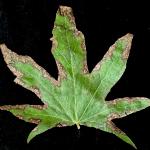 Marginal leaf browning and twig dieback throughout the canopy of a mature sweetgum (Liquidambar styraciflua). The tree is believed to be 50 years old and resides in a shaded and closed setting with many other trees and a tall structure. The marginal leaf browning was uniform on the submitted foliage and caused by the pathogen Tubakia. Tubakia leaf blotch is common on oaks (Quercus) in the region, and while the fungus is known to occur on other hardwoods, infections are believed to be uncommon. However, several recent studies have illustrated greater species diversity in the genus than was previously known, suggesting a broader host range is likely. Additionally, the twigs exhibited swollen cankers with rough margins and irregular wound wood. Shaving the bark revealed darkly stained vascular tissue and the fungal pathogen Botryosphaeria emerged following incubation.
Marginal leaf browning and twig dieback throughout the canopy of a mature sweetgum (Liquidambar styraciflua). The tree is believed to be 50 years old and resides in a shaded and closed setting with many other trees and a tall structure. The marginal leaf browning was uniform on the submitted foliage and caused by the pathogen Tubakia. Tubakia leaf blotch is common on oaks (Quercus) in the region, and while the fungus is known to occur on other hardwoods, infections are believed to be uncommon. However, several recent studies have illustrated greater species diversity in the genus than was previously known, suggesting a broader host range is likely. Additionally, the twigs exhibited swollen cankers with rough margins and irregular wound wood. Shaving the bark revealed darkly stained vascular tissue and the fungal pathogen Botryosphaeria emerged following incubation.
Bacterial leaf scorch (BLS), caused by Xylella fastidiosa, of American elm (Ulmus americana). The tree is very large and believed to be well over 100 years old. It resides in a full sun setting with well-drained soils and was injected with Alamo (propiconazole) in June for control of Dutch elm disease (DED). In early August, numerous epicormic sprouts on the main trunk and a few scattered secondary branches in the upper canopy rapidly browned and wilted. The foliage appeared brown and scorched with symptoms more severe close to the leaf midrib. Molecular testing confirmed the presence of X. fastidiosa and Dutch elm disease is not believed to be present. This pathogen is a member of a group known as “fastidious xylem-inhabiting bacteria” (FXIB), which cannot be readily cultured, making their identification challenging. The sample originated from outside New England and BLS is still considered rare in Massachusetts. However, targeted surveys have not been conducted in the Commonwealth and the true distribution of the pathogen remains largely unknown.
Cedar-quince rust (Gymnosporangium clavipes), and subsequent colonization by the cankering pathogen Diplodia, on serviceberry (Amelanchier canadensis) and common medlar (Mespilus germanica). The serviceberry is approximately 20 years old and grows in shade at the edge of a managed landscape in a soil mix with good drainage. Leaf yellowing and shedding was observed in July and the symptoms were not present in previous years. Medlar is a large shrub to small tree and a member of the rosaceous family. This rare ornamental (a first-time submission in the diagnostic lab) is over 30 years old and experiences full sun in a mulched garden with drip irrigation. This plant exhibited shoot tip dieback with gall-like cankers throughout the canopies. Symptoms have been observed in previous years. On rosaceous hosts, cedar-quince rust can create swollen twig and branch cankers that extrude large masses of rust spores in July and parts of August. The diseased tissue can be subsequently colonized by opportunistic cankering fungi. In this case, Diplodia was present on both samples and this fungus is known to attack stressed and weakened woody plants in the region, especially oak (Quercus). Pruning and removal of the diseased tissue is the best course of management to reduce overwintering inoculum.
Report by Nick Brazee, Plant Pathologist, UMass Extension Plant Diagnostic Lab, UMass Amherst
Insects and Other Arthropods
The Professional Insect and Mite Management Guide for Woody Plants is freely available at https://ag.umass.edu/insectmiteguide. Please let me know how it is or isn’t working for you by responding to the following Feedback Form: Professional Insect & Mite Management Guide for Woody Plants. Your feedback is valuable and I cannot wait to hear from you!
Note: Our website is undergoing updates, and as such, the collapsible menus on the home page of the Guide are currently not functioning. Thank you for your patience as we await these updates.
Invasive Updates:
- Asian Longhorned Beetle is still present in Worcester, Shrewsbury, Boylston, West Boylston, and parts of Holden and Auburn, MA. If you suspect you’ve found this insect or the damage it causes, please report it to the Asian Longhorned Beetle Eradication Program office in Worcester, MA at 508-852-8090 or toll free at 1-866-702-9938.
Now is the time to monitor for adult Asian longhorned beetles! The USDA APHIS considers August "Tree Check Month", so get out there and look at those maples! When in doubt about the identity of a longhorned beetle, always report it. For more information, visit this article: USDA APHIS Asks for Help Looking for Asian Longhorned Beetle by Checking Trees.
To report an Asian longhorned beetle find online or to compare it to common insect look-alikes, visit the Asian Longhorned Beetle Report page from the MA Department of Agricultural Resources.
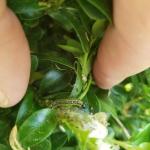

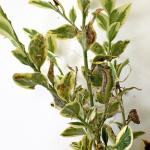
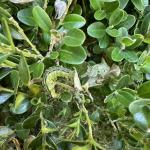 Box Tree Moth has been detected in the following Massachusetts communities: Bourne, Sandwich, and Barnstable. A map of these locations is available at MDAR’s Invasive Pest Dashboard. If you believe you have found this insect, please take a photo, note your location, and report it immediately to the MA Department of Agricultural Resources using their Report a Pest Form. Box tree moth caterpillars were reported to be active at certain locations on Cape Cod, MA as of the week of April 19th. C.L. Fornari reports on 6/8/2024 that box tree moth pupae are present at a location in Sandwich, MA at this time (see photos). These pupae are likely the overwintered caterpillars that were actively feeding in April which will give rise to the next generation of adults.
Box Tree Moth has been detected in the following Massachusetts communities: Bourne, Sandwich, and Barnstable. A map of these locations is available at MDAR’s Invasive Pest Dashboard. If you believe you have found this insect, please take a photo, note your location, and report it immediately to the MA Department of Agricultural Resources using their Report a Pest Form. Box tree moth caterpillars were reported to be active at certain locations on Cape Cod, MA as of the week of April 19th. C.L. Fornari reports on 6/8/2024 that box tree moth pupae are present at a location in Sandwich, MA at this time (see photos). These pupae are likely the overwintered caterpillars that were actively feeding in April which will give rise to the next generation of adults.
Adult box tree moths have been reported arriving at blacklight traps on Cape Cod, MA as of 6/24/2024 and by others monitoring the same area the week prior. A new generation of box tree moth caterpillars for the 2024 season was reported by C.L. Fornari on Cape Cod as of 7/18/2024. It remains important to monitor boxwood for this pest.
The USDA APHIS has announced a new quarantine for box tree moth in Massachusetts and Ohio, and has expanded existing quarantines in Michigan and New York. This includes conditions for interstate movement of regulated Buxus species. This quarantine includes the entire Commonwealth of Massachusetts. The federal order states:
“Boxwood plants may only be moved interstate from a quarantined area from an establishment operating under a compliance agreement, and only if accompanied by a certificate issued by a State Agricultural Authority certifying that the requirements of this Federal Order and the compliance agreement have been met. These requirements will prevent producers and distributors of boxwood from moving infested plants interstate. State Agricultural Authorities may prescribe additional safeguards and protocols.
All other regulated articles of boxwood, including plant parts, pieces, cuttings, clippings, debris, and any portion of the plant, alive or dead, except for decorative purposes, are prohibited from movement.”
MDAR has recently sent a notice to boxwood growers in Massachusetts of the following:
"Effective May 22, 2024, the USDA has issued a Federal Order establishing a quarantine for the entire state of Massachusetts. In an effort to restrict the movement of box tree moth, boxwoods (Buxus spp.) may no longer be exported from Massachusetts except by an establishment operating under a compliance agreement (CA) to be issued by MDAR. Anyone wishing to register for a CA must go to the Massachusetts Department of Agricultural Resources box tree moth page and click on the EXPORTS link, and fill out the form. An MDAR staff person will follow up within one week. Please note that the quarantine does NOT restrict in-state sales, movement within the state, or import of boxwoods into Massachusetts. If you have any further questions, please feel free to contact either MDAR (taryn.lascola@mass.gov) or USDA (203-741-5641)."
To read the full announcement of the box tree moth quarantine for Massachusetts from MDAR, please visit the Massachusetts Introduced Pests Outreach Blog.
Need information about monitoring and trapping box tree moth? Check out this newly available Box Tree Moth Monitoring & Trapping fact sheet from UMass Extension.
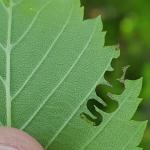
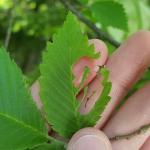 Elm Zigzag Sawfly has been detected in the following Massachusetts communities: Tyringham, Washington, Williamsburg, Amherst, Great Barrington, New Ashford, Dalton, Chesterfield, Holyoke, Hinsdale, Granby, Greenfield, Westfield, Chester, Deerfield, Becket, Sunderland, Williamstown, and Windsor. A map of these locations can be found on the MA DCR Forest Health Program Elm Zigzag Sawfly page. If you believe you have found this insect, please take a photo, note your location, and report it immediately using MA DCR’s Massachusetts Elm Zigzag Sawfly Reporting Form. Felicia Hubacz, MA DCR, reports elm zigzag sawfly larvae actively feeding in the Becket, MA population as of 5/28/2024. UMass Extension observed tiny elm zigzag sawfly feeding in the Windsor, MA population on 5/31/2024 (see photos).
Elm Zigzag Sawfly has been detected in the following Massachusetts communities: Tyringham, Washington, Williamsburg, Amherst, Great Barrington, New Ashford, Dalton, Chesterfield, Holyoke, Hinsdale, Granby, Greenfield, Westfield, Chester, Deerfield, Becket, Sunderland, Williamstown, and Windsor. A map of these locations can be found on the MA DCR Forest Health Program Elm Zigzag Sawfly page. If you believe you have found this insect, please take a photo, note your location, and report it immediately using MA DCR’s Massachusetts Elm Zigzag Sawfly Reporting Form. Felicia Hubacz, MA DCR, reports elm zigzag sawfly larvae actively feeding in the Becket, MA population as of 5/28/2024. UMass Extension observed tiny elm zigzag sawfly feeding in the Windsor, MA population on 5/31/2024 (see photos).
Elm zigzag sawfly feeding continues to be very apparent on infested trees. Look for the diagnostic zigzag feeding pattern on elm leaves, as well as the more cryptic defoliation that occurs as the zigzags coalesce (see photos). Please report any suspicious defoliation of elm to the previous reporting link.
- Emerald Ash Borer is well established across most of Massachusetts. A map of these locations from the MA Department of Conservation and Recreation is available.
- Jumping Worms are non-native earthworms that impact natural ecosystems. Available resources include a fact sheet about earthworms in Massachusetts and jumping worm FAQ’s. In August, adult jumping worm sightings typically increase due to the life cycle of these earthworms and their large and noticeable size at this time of year.
- Spotted Lanternfly now has established populations in the following locations in Massachusetts: Holyoke, Springfield, West Springfield, Agawam, Fitchburg, Worcester, Shrewsbury, Southborough, Ashland, Wellesley, Weston, Chelmsford, Grafton, Lawrence, Lynn, Wilbraham, Ludlow, and Chicopee, MA. The MA Department of Agricultural Resources reported that spotted lanternfly egg hatch had begun in Holyoke and Springfield, MA as of 5/14/2024. As of 7/19/2024, MDAR reports mostly 4th instar spotted lanternfly nymphs and a few adult spotted lanternflies active at known populations in the Connecticut River Valley.
In areas of the state where spotted lanternfly is present and has been observed through monitoring, the SLF Management Guide suggests management options for SLF nymphs and adults. Spotted lanternfly should not be managed using insecticides in locations where the insect has not been confirmed in the state. This may result in unnecessary, costly, and environmentally irresponsible applications. The first step in areas outside of the communities listed above for MA is to report SLF to MDAR (also see link below).
For homeowners now living with spotted lanternfly in Massachusetts, the MA Department of Agricultural Resources offers the following decision-making guides:
• Checklist for residents living in infested areas
• Checklist for businesses in infested areas
• Management guide for homeowners
If you believe you have found this insect, please take a photo, note your location, and report it immediately using the Spotted Lanternfly Report Form. Available resources include a map of spotted lanternfly locations in Massachusetts from the MA Department of Agricultural Resources, MDAR’s spotted lanternfly fact sheet, UMass Extension’s Spotted Lanternfly Management Guide, and an SLF InsectXaminer episode.
Medically Important Pests:
- Ticks are a serious public health concern and may be active in managed landscapes any time temperatures are above freezing.
Check your children and loved ones and selves for ticks daily! High exposure risk, such as recreational and work time outdoors, summer camps, and back-to-school time outside combined with tick activity is a recipe for tick bites. Check your entire body and remove any attached ticks immediately. If an attached tick is found, submit the tick to one of the testing resources in the link below and go see your physician immediately. Lyme disease is only one of the pathogens ticks can vector. Others include but are not limited to babesiosis, anaplasmosis, ehrlichiosis, and many more!
Blood tests for tick borne pathogens are available. Ask your doctor about FA and Western blot testing. A doctor may prescribe doxycycline or amoxicillin or other antibiotics to treat certain tick-borne pathogens. Remember, the pathogen that causes babesiosis is different and requires different treatment! Co-infections are possible – meaning more than one pathogen may be present at a time. Test for all of them. UMass Extension cannot provide medical advice. This information is for educational purposes only.
Encounters with deer ticks can increase in New England in April, October, and November; however, precautions should be taken year-round to prevent tick bite exposure. Available resources include tick information from Cape Cod Cooperative Extension, personal protective measures, and a list of potential tick testing resources. The New England Center of Excellence in Vector-Borne Diseases (NEWVEC) also provides the latest tick information and resources.
- Mosquitoes and the diseases they vector are also a serious public health concern in Massachusetts by summer. Available resources include Mosquito Repellents from the Department of Public Health and Prevent Mosquito Bites from the Centers for Disease Control and Prevention. The Massachusetts Department of Public Health tests for Eastern Equine Encephalitis (EEE) and West Nile Virus (WNV) from June to October. The Massachusetts risk maps are currently available for both EEE and WNV.
As of August 15th, EEE has been detected in mosquito samples taken from Plymouth, Barnstable, and Essex counties in Massachusetts. The MA Department of Public Health now ranks certain communities at moderate risk (meaning there is EEE in mosquito populations in that area now) in these counties. Middleborough, Carver, and Plymouth, MA are ranked as high risk (meaning “conditions likely to lead to infection of a person with EEE are occurring in your area”). People living and working in these communities should take the precautions as suggested in the links above to protect themselves from mosquito bites.
As of August 15th, WNV risk has been increased to moderate (infection with WNV is likely or has already occurred) in many communities in the following Massachusetts counties: Norfolk, Plymouth, Bristol, Dukes, Middlesex, Worcester, Hampden, Essex, Suffolk, and Berkshire. Individuals in these areas should continue to take precautions to protect themselves from mosquito bites.
As of 8/15/2024 there have been 46 EEE positive and 237 WNV positive mosquito samples in MA. As of 8/15/2024, the MA Department of Public Health announced the season's second human case of West Nile virus in Massachusetts.
- Wasps/Hornets: Many wasps are predators of other arthropods, including pest insects such as certain caterpillars that feed on trees and shrubs. Adult wasps hunt prey and bring it back to their nest where young are being reared as food for the immature wasps. A common such example are the paper wasps (Polistes spp.) who rear their young on chewed up insects. Paper wasps can sting, and will defend their nests, which are open-celled paper nests that are not covered with a papery “envelope”. These open-celled nests may be seen hanging from eaves or other outdoor building structures. Aerial yellow jackets and hornets create large aerial nests that are covered with a papery shell or “envelope”. Common yellow jacket species include those in the genus Vespula. Dolichovespula maculata is commonly known as the baldfaced hornet, although it is not a true hornet. The European hornet (Vespa crabro) is three times the size of a yellow jacket and may be confused for the northern giant hornet (Vespa mandarinia). The European hornet is known to Massachusetts, but the northern giant hornet is not. If you are concerned that you have found or photographed a northern giant hornet, please report it using the MA Department of Agricultural Resources Report Pest Sightings page. Some people are allergic to stinging insects, so care should be taken around wasp/hornet nests. Unlike the European honeybee (Apis mellifera), wasps and hornets do not have barbed stingers and therefore can sting repeatedly when defending their nests. It is best to avoid them and, if that cannot be done and assistance is needed to remove them, consult a professional.
Tree & Shrub Insect & Mite Pest Suggested Scouting:
- Andromeda Lace Bug is most commonly encountered on Japanese andromeda, however other host plants may be impacted. Most activity from this insect occurs between late May through September, with several generations occurring per year. Both nymphs and adults feed on host plant leaf undersides and cause white/yellow-colored spots or chlorosis to occur on host plant leaf surfaces.
- Azalea Lace Bug is a pest of both deciduous and evergreen azaleas (Rhododendron spp.), however resistance has been reported in Rhododendron atlanticum, R. arborescens, R. canescens, R. periclymenoides, and R. prunifolium. The insects feed on host plant leaf undersides, and cause chlorosis on leaf surfaces. Azalea lace bugs are active throughout the summer.
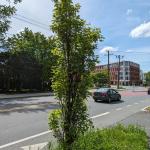
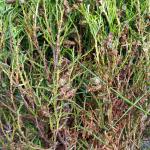
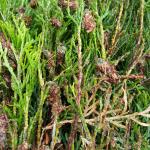 Bagworm caterpillar feeding is underway! A sample of emerald green arborvitae from Hampshire County was submitted to the UMass Plant Diagnostic Laboratory on 7/23/2024, filled with bagworm caterpillars. Browning of foliage was evident from their feeding. A population of this size can easily work its way down a hedge, defoliating the plants as they go. By August, caterpillars and their associated bags will be very large, and the defoliation and feeding damage on host plant leaves they can cause will be quite noticeable by then.
Bagworm caterpillar feeding is underway! A sample of emerald green arborvitae from Hampshire County was submitted to the UMass Plant Diagnostic Laboratory on 7/23/2024, filled with bagworm caterpillars. Browning of foliage was evident from their feeding. A population of this size can easily work its way down a hedge, defoliating the plants as they go. By August, caterpillars and their associated bags will be very large, and the defoliation and feeding damage on host plant leaves they can cause will be quite noticeable by then.- Cryptomeria Scale first generation crawlers are present from approximately 600-800 GDD's and second generation crawlers are present from 1750-2130 GDD's. Look for discolored needles on susceptible host plants. Check the undersides of needles for the hardened scale covers and/or yellow crawlers. Crawlers present in June and August. Scout for scale insects on the underside of needles on the inside of bottom branches first. Scouting on overcast days may make it easier to see the symptoms caused by cryptomeria scale infestation. Yellow sticky cards can be placed in infested trees to aid in scouting for adult (winged) male emergence. Egg laying will begin soon after males are seen. Check scale covers for round exit holes left behind by natural enemies.
- Dogwood Borer is a species of clearwing moth whose larvae bore not only into dogwood (Cornus), but hosts also include flowering cherry, chestnut, apple, mountain ash, hickory, pecan, willow, birch, bayberry, oak, hazel, myrtle, and others. Kousa dogwood appears to be resistant to this species. Signs include the sloughing of loose bark, brown frass, particularly near bark cracks and wounds, dead branches, and adventitious growth. The timing of adult emergence can be expected when dogwood flower petals are dropping and weigela begins to bloom. Adult moth flights continue from then until September.
- Dusky Birch Sawfly second generation larvae may be present on various species of birch (Betula) at this time. Second generation adults may emerge by mid-July, laying eggs which will hatch and feeding larvae may be present until mid-September. While small trees may be defoliated by these feeding Hymenopteran caterpillars, in the majority of cases feeding by this insect rarely reaches levels where chemical intervention is necessary. Btk (Bacillus thuringiensis kurstaki) does not work on sawfly larvae.

 Eastern Spruce Gall Adelgid galls are still green and not yet dried and cracked open to release the winged, mobile insects within. The galls in these photos are from a Christmas tree grower in Athol, MA experiencing an infestation of this European insect on a single white spruce. During this time, these insects are very well protected from harsh abiotic conditions, predators, and parasites. By late summer, these galls dry out, crack open, and the nearly mature nymphs emerge. Once "on the outside", these nymphs develop into winged females who will lay another crop of eggs coated in white woolly wax, which will hatch into the nymphs who will spend the winter near a terminal twig or dormant bud. Remove and destroy galls before they open.
Eastern Spruce Gall Adelgid galls are still green and not yet dried and cracked open to release the winged, mobile insects within. The galls in these photos are from a Christmas tree grower in Athol, MA experiencing an infestation of this European insect on a single white spruce. During this time, these insects are very well protected from harsh abiotic conditions, predators, and parasites. By late summer, these galls dry out, crack open, and the nearly mature nymphs emerge. Once "on the outside", these nymphs develop into winged females who will lay another crop of eggs coated in white woolly wax, which will hatch into the nymphs who will spend the winter near a terminal twig or dormant bud. Remove and destroy galls before they open.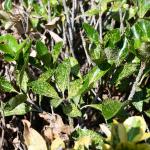
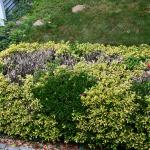 Euonymus Scale overwinters as a fertilized female. Eggs are laid beneath dark brown female scale covers in the early spring. Egg hatch occurs over a 2-3 week period, with crawlers present by early June. A second generation of crawlers may be present by mid-July, with adults present again in August and September. While Euonymus spp. host plants are preferred, additional host plants have been reported. These images are from a severe euonymus scale infestation submitted to the UMass Plant Diagnostics Laboratory.
Euonymus Scale overwinters as a fertilized female. Eggs are laid beneath dark brown female scale covers in the early spring. Egg hatch occurs over a 2-3 week period, with crawlers present by early June. A second generation of crawlers may be present by mid-July, with adults present again in August and September. While Euonymus spp. host plants are preferred, additional host plants have been reported. These images are from a severe euonymus scale infestation submitted to the UMass Plant Diagnostics Laboratory.- Fall Home-Invading Insects: Various insects, such as ladybugs, boxelder bugs, seedbugs, and stink bugs will begin to seek overwintering shelters in warm places, such as homes, throughout the next couple of months. While such invaders do not cause any measurable structural damage, they can become a nuisance, especially when they are present in large numbers. While the invasion has not yet begun, if you are not willing to share your home with such insects, now should be the time to repair torn window screens, repair gaps around windows and doors, and seal up any other gaps through which they might enter the home.
 Hickory Tussock Moth caterpillars are out and about, as is common this time of year. Lophocampa caryae is native to North America with caterpillars of this species found from July through September. These white, black and hairy caterpillars may be seen wandering landscapes. Hickory, walnut, hornbeam, and others are favored host plants, although these caterpillars may be seen on many other trees and shrubs. The hairy caterpillars themselves or their cocoons may cause dermatitis in sensitive individuals, especially children. Avoid handling and teach children to ask an adult first before picking up a hairy caterpillar. Typically does not require management.
Hickory Tussock Moth caterpillars are out and about, as is common this time of year. Lophocampa caryae is native to North America with caterpillars of this species found from July through September. These white, black and hairy caterpillars may be seen wandering landscapes. Hickory, walnut, hornbeam, and others are favored host plants, although these caterpillars may be seen on many other trees and shrubs. The hairy caterpillars themselves or their cocoons may cause dermatitis in sensitive individuals, especially children. Avoid handling and teach children to ask an adult first before picking up a hairy caterpillar. Typically does not require management.- Japanese Beetle adults were reported active at the end of June in MA in 2024 (see scouting reports above). Adult beetles skeletonize the leaves of susceptible host plants, often feeding on roses, grapes, and shrubs first and moving to the foliage of trees as the season continues. Adults are typically active from late June to early August.
-
Locust Borer adult beetles are typically active by early September until the first frost, often associated with goldenrod. Beetles are attractive – black with a series of yellow stripes throughout the body and approximately ½-1 inches long. Black locust (Robinia pseudoacacia) is the host of the wood boring larvae of this visually striking insect.
-
Magnolia Scale reports to UMass Extension have increased as now is the time when adult female scales are large, covered in a white, waxy coating, and very noticeable. Nymphs will soon wander to the newest twigs of their host plants where they will settle to overwinter. When safe and practical to do so, such as on smaller trees, large female scales can be removed with a soft brush (without damaging the host plant bark). See link for more management options.
-

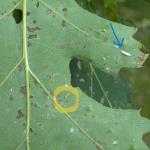
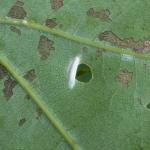 Oak Skeletonizer populations have been noticeable in forested locations in the Williamsburg, MA area in recent years. A park tree in Ashfield, MA showed signs of the activity of this insect on 7/6/2024 as shown here. The oak skeletonizer is a native species of New England and elsewhere in the eastern United States and parts of Canada. Deciduous oaks and chestnut are hosts for this insect. Occasionally, this insect has a large outbreak population. For example, in 1971 in New York, trees were damaged by this insect by July and a second generation was found by September. In 1959 and 1960, two generations per year were observed in Michigan (Gibbons and Butcher, 1961).
Oak Skeletonizer populations have been noticeable in forested locations in the Williamsburg, MA area in recent years. A park tree in Ashfield, MA showed signs of the activity of this insect on 7/6/2024 as shown here. The oak skeletonizer is a native species of New England and elsewhere in the eastern United States and parts of Canada. Deciduous oaks and chestnut are hosts for this insect. Occasionally, this insect has a large outbreak population. For example, in 1971 in New York, trees were damaged by this insect by July and a second generation was found by September. In 1959 and 1960, two generations per year were observed in Michigan (Gibbons and Butcher, 1961).Foliage of the red oak group is skeletonized by this species. Leaves become translucent and eventually dry out. Heavily attacked foliage will appear lacey from the skeletonizing. Occasional outbreaks can cause damage over a large area, and repeated years of defoliation can cause a reduction in host plant growth. Occasionally, part of the tree crown may be killed by the activity of this insect. However, the oak skeletonizer is often found in low level, non-damaging populations and their presence can be tolerated.
Visually monitor for the activity of this insect in late May or early June (first generation). Look for skeletonized host plant leaves and eventually the characteristic white, ribbed cocoons. Trees can tolerate this native insect and often chemical management is not necessary.
-
Obscure Scale may be present on oak, chestnut, hickory, or pecan. Newly hatched crawlers may be active on infested stems and branches for a long period of time, roughly between mid-July through September. Because the scale coverings, even of dead scales, cling to the host plant bark, heavy infestations that have been present for multiple years may be detected any time of the year if the layered, encrusted scales are searched for. Take note if branches appear deformed or lumpy/misshapen.
- Pear Sawfly is an introduced (European) species that feeds on a wide variety of trees and shrubs, including pear, cherry, cotoneaster, crabapple, hawthorn, mountain ash, plum, and shadbush. Sawfly larvae feed on the leaves of their hosts, skeletonizing them at first and eventually leading to leaf browning and early leaf loss. A second generation of adult sawflies may emerge from pupal cells in the soil by August. Second generation larvae may feed on host plant leaves through September until they drop to the soil to overwinter as pupae.
- Pine Needle Scale can be a very serious pest of the needles of ornamental pines. Light infestations may go unnoticed and typically do not cause considerable damage. As a population increases, this scale insect feeds with piercing-sucking mouthparts to remove host plant fluids from the needles, causing them to eventually turn yellowish in color and possibly brown. Twigs and entire branches may eventually be killed. Lower branches typically die first. Depending upon geographic location, one or two generations of pine needle scales occur per year. If a second generation is present, second-generation crawlers are present by late July through September. Two generations per year occur in Massachusetts. More northerly locations may have a single generation per year.
- Pitch Mass Borer overwinters in the pitch mass found on the host plant. This insect tunnels beneath the bark, into the cambium. It may take up to two years for the pitch mass borer to mature. Pupation typically occurs by the end of May through June, in time for adult clearwing moth emergence in July and August.

 Redheaded Flea Beetle (Systena frontalis) has been identified as a native pest of nurseries in many locations in the eastern United States. Suspected redheaded flea beetle damage was seen on Ilex crenata 'Dwarf Pagoda' (Dwarf Pagoda Japanese holly) on 3/27/2024 that was purchased in Massachusetts but may have originated in NJ. While identification of this species of insect is uncertain based on host plant damage alone, it appears to be a reasonable and educated assumption. Redheaded flea beetles are known to feed on a wide variety of host plants. These include but are not limited to: cabbage, beans, beets, blueberries, and other agricultural crops as well as Physocarpus, Weigelia, Cornus, Forsythia, Itea, Hydrangea, and Ilex. Adult beetles are active and feed from approximately late-June to mid-September on the upper and lower leaf surfaces of their hosts. This can cause damage that looks like skeletonization and eventually holes in the leaves. Leaves appear covered in brown patches as in these photos. This damage was caused last season on this evergreen plant.
Redheaded Flea Beetle (Systena frontalis) has been identified as a native pest of nurseries in many locations in the eastern United States. Suspected redheaded flea beetle damage was seen on Ilex crenata 'Dwarf Pagoda' (Dwarf Pagoda Japanese holly) on 3/27/2024 that was purchased in Massachusetts but may have originated in NJ. While identification of this species of insect is uncertain based on host plant damage alone, it appears to be a reasonable and educated assumption. Redheaded flea beetles are known to feed on a wide variety of host plants. These include but are not limited to: cabbage, beans, beets, blueberries, and other agricultural crops as well as Physocarpus, Weigelia, Cornus, Forsythia, Itea, Hydrangea, and Ilex. Adult beetles are active and feed from approximately late-June to mid-September on the upper and lower leaf surfaces of their hosts. This can cause damage that looks like skeletonization and eventually holes in the leaves. Leaves appear covered in brown patches as in these photos. This damage was caused last season on this evergreen plant.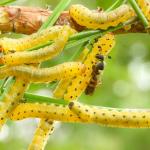
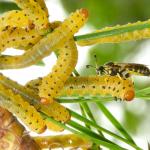 Redheaded Pine Sawfly larvae feed on the outside of host plant needles. This results in shriveled, browned, and straw-like needles that remain attached to the hosts. Older caterpillars are capable of eating the entire needle. Feeding began in the spring and early summer, and can sometimes be extensive by the fall. Redheaded pine sawfly larvae were observed on 8/3/2024 in the Montague Sandplains (Montague and Franklin County, MA) by Dr. Paul Sievert, emeritus faculty of UMass Amherst. Parasitoid wasps possibly in the genus Exenterus were observed interacting with the larvae (see photos).
Redheaded Pine Sawfly larvae feed on the outside of host plant needles. This results in shriveled, browned, and straw-like needles that remain attached to the hosts. Older caterpillars are capable of eating the entire needle. Feeding began in the spring and early summer, and can sometimes be extensive by the fall. Redheaded pine sawfly larvae were observed on 8/3/2024 in the Montague Sandplains (Montague and Franklin County, MA) by Dr. Paul Sievert, emeritus faculty of UMass Amherst. Parasitoid wasps possibly in the genus Exenterus were observed interacting with the larvae (see photos). 
 Red-humped Caterpillar larvae are quite large and hungry right now! Red-humped caterpillars develop into a type of prominent moth (Family: Notodontidae) and are sometimes defoliators of ornamental trees and shrubs in their larval stage. Host plants of S. concinna include apple and crabapple, but many woody plant hosts have been reported, comprising of but not limited to pear, cherry, plum, sweetgum, walnut, redbud, willow, and persimmon, as pictured here. Caterpillars feed in groups when first hatched from their egg, often skeletonizing the underside of leaves initially. As the caterpillars grow in size, they are capable of consuming entire leaves. They often feed on the same limb/branch together in a group, stripping everything except the leaf veins. These larvae are typically more problematic on smaller trees, whereas larger trees may not be extensively impacted.
Red-humped Caterpillar larvae are quite large and hungry right now! Red-humped caterpillars develop into a type of prominent moth (Family: Notodontidae) and are sometimes defoliators of ornamental trees and shrubs in their larval stage. Host plants of S. concinna include apple and crabapple, but many woody plant hosts have been reported, comprising of but not limited to pear, cherry, plum, sweetgum, walnut, redbud, willow, and persimmon, as pictured here. Caterpillars feed in groups when first hatched from their egg, often skeletonizing the underside of leaves initially. As the caterpillars grow in size, they are capable of consuming entire leaves. They often feed on the same limb/branch together in a group, stripping everything except the leaf veins. These larvae are typically more problematic on smaller trees, whereas larger trees may not be extensively impacted.- Sugar Maple Borer is a native pest of sugar maples in New England. Adult beetles are brightly colored with yellow stripes alternating with black. Adults may be confused with the previously mentioned locust borer. Adult sugar maple borers lay their eggs in sugar maple bark in late July and early August.
- Southern Pine Beetle has been trapped in Massachusetts since 2015. By 2022 and 2023, southern pine beetle has reached outbreak conditions in small areas of the state, killing pitch pine (Pinus rigida), particularly on Martha’s Vineyard and Nantucket islands in MA. If you believe you have found infested pitch pine in Massachusetts, please report southern pine beetle using the Massachusetts Southern Pine Beetle Reporting Form from MA DCR.
-
Tuliptree Aphid is a native North American insect that occurs wherever the tuliptree grows. Depending upon local temperatures, these aphids may be present from mid-June through early fall. There are several generations per year. The tuliptree aphid can cause reduced leaf size as a result of its feeding. These insects feed on their host plants with piercing-sucking mouthparts which they use to remove host plant fluids. Some leaves, especially those in the outer canopy, may turn brown or yellow and drop from infested trees prematurely.
The most significant impact these aphids can have is typically the resulting honeydew, or sugary liquid excrement, which may be present in excessive amounts and coat leaves and branches, leading to sooty mold growth. This honeydew may also make a mess of anything beneath the tree, including sidewalks and parked cars. Ants, bees, wasps, and flies may be attracted to and feed on the honeydew. Management is typically not necessary, as this insect does not significantly impact the overall health of its host.
- Twospotted Spider Mite season is under way as warm temperatures rise! Populations on many different deciduous and some coniferous hosts may rise from 363-618 GDD's and again from 1300-2000 GDD's. Twospotted spider mites prefer hot, dry conditions in the summer and fall. Population increases and subsequent plant damage can occur under these conditions. Using piercing-sucking mouthparts, mites feed primarily on the underside of host plant leaves and remove fluids. This feeding causes graying or yellowing of the leaves. Necrotic spots can also occur in advanced stages of leaf damage. This may lead to a stippled/bleached appearance of leaves; on occasion, complete defoliation due to spider mite activity is possible under high populations. Twospotted spider mites also create a fine webbing which can be found on infested plants.
Magnification is needed to visually detect twospotted spider mites. At least a 10-15X hand lens is required. The undersides of host plant leaves can be examined for the mites themselves or their shed or cast skins, as well as the fine webbing left behind by spider mites. However, it may be easier to view twospotted spider mites when a branch that is suspected to be infested is shaken or struck over a white piece of paper. See previous link for more details.
- Viburnum Leaf Beetle larvae may be found anywhere on the leaves and usually in groups. When young, larvae feed on the undersides of the leaves. As they grow larger, they may feed on the upper surface. Larval development may take approximately 8-10 weeks to complete and 3 larval instars are reported. Pupae are yellowish and are found in the soil beneath the host plant. Adults emerge around the middle of July and are brown, smaller than the largest larvae (approximately ¼ inch), and will also feed on the leaves. Adults are present in the landscape until the first hard frost.
- White Marked Tussock Moth is one of many native tussock moth species commonly encountered in the late summer and early fall. Avoid touching these caterpillars or their cocoons: they may cause allergic reactions, especially if their hairs come into contact with sensitive skin (ex. back, stomach, underside of arms) (Wagner, 2005). Contact dermatitis (itching) as a result of interacting with these insects has been reported from schools and daycares. Teach children how to identify and avoid handling cocoons and caterpillars. These caterpillars have urticating (irritating) hairs. Welts may appear on the skin within minutes, but subside the next day; however, itching can last for several days depending upon the sensitivity of the individual.
- White Prunicola Scale is an armored scale that has been on occasion found in samples submitted to the UMass Plant Diagnostics Laboratory. Trunks and branches primarily of Japanese flowering cherry, lilac, and privet are infested by the white prunicola scale. Feeding may reduce tree vigor and foliage may yellow or become sparse. Two generations may occur per year in New England, with eggs/crawlers in early June and again in early August. However, under warmer conditions, three generations per year are possible.
- Yellow Poplar Weevil is also known as the sassafrass weevil, the magnolia leafminer, or the tulip tree leafminer. This insect, as all of these common names suggest, feeds on yellow poplar (tulip tree; Liriodendron tulipifera), sassafras (Sassafras albidum), magnolia (Magnolia spp.), as well as bay laurel (Laurus nobilis). Adult beetles lay eggs in the midribs of host plant leaves by May, after which the eggs hatch and larvae feed by creating blotch mines in the leaves. Larvae can be observed in May and June, and adults emerging to feed again by August, prior to overwintering in sheltered areas.
Beneficials/Non-Pests:

 European Mantids have recently been described as the “t-rex’s” of the terrestrial insect world. As the mother of a 5-year old, I love that description!
European Mantids have recently been described as the “t-rex’s” of the terrestrial insect world. As the mother of a 5-year old, I love that description!
The Mantidae (the family containing insects commonly known as praying mantises) are charismatic insects known for their abilities as predators of other insects. Mantids possess raptorial (grasping) forelegs which allow them to ambush and catch prey items that cross their path. These hunters are fascinating to many observers to watch, and the impressive size of certain species can be intimidating to passersby.
We have a few different species of mantids in Massachusetts and the eastern United States, including the European mantid, Mantis religiosa, pictured here. The Chinese mantid (Tenodera sinensis) is very large, usually up to just over 4 inches in length, and is generally brown in color with green and yellow striping along the sides of the wings. It is typically considered the largest mantid species known to North America, but may be confused with the narrow-winged mantis (Tenodera angustipennis). Additional mantid species found in the US include the Carolina mantid (Stagmomantis carolina), California mantid (S. californica), and Florida mantid (S. floridensis). The Stagmomantis species are native.
Mantids develop from eggs that are laid in masses (an ootheca) which some have described as having a similar appearance to a packing peanut. Immatures resemble the adults, but lack wings until the adult stage.
The Chinese mantid was frequently sold as a predator of garden pests; however, its ability to manage garden pests is thought to be overstated. These large and indiscriminate predators may also be seen capturing and eating beneficial insects such as bees, wasps, and other desirable species visiting flowers. As such, the purchase of mantids for the biological control of pest insects (especially smaller pests such as aphids, mites, and scales, which are not on the menu for mantids that prefer larger prey), is not typically recommended for gardeners.
Report by Tawny Simisky, Extension Entomologist, UMass Extension Landscape, Nursery & Urban Forestry Program
Landscape Weeds
For information about identification of weeds noted below, check out UMass Extension's Weed Herbarium.
Common reed or phragmites, Phragmites australis, is now in flower in New England, so now is the time for herbicide treatment. Glyphosate-based herbicide products are the best choice for the control of common reed. In areas near water, a formulation of glyphosate that is labeled for these areas should be used. Common reed is commonly associated with water and wet habits and controls implemented in these areas will likely invoke the Massachusetts Wetland Protection Act 310 CMR 10.00 and the management of this invasive plant will require a permit. See additional comments about 310 CMR 10.00 in the Japanese knotweed paragraph below.
Crabgrass management in turf: Summer is chugging along and so is the growth and development of crabgrass in turf settings. As crabgrass grows and produces more tillers, options for effective control decrease. At this point in the season, most crabgrass is 5-tiller or larger. For control of these large, several tiller crabgrass plants, the use of quinclorac (Drive WLR8TM or other post-patent products) should be considered. Applications will require the addition of a high-quality MSO (methylated seed oil) surfactant for effective control. The late season control of crabgrass with quinclorac still has the chance to stop flowering and the subsequent production of seed that will be added to the weed seed bank. Sometimes referred to as a “rescue application”, late season crabgrass control will get crabgrass out of the way in preparation for late summer and early fall overseeding.
English ivy (Hedera helix): I have received a couple of inquiries about whether English ivy (Hedera helix) is invasive in Massachusetts. These inquiries also ask about the best way to control English ivy. The Massachusetts Invasive Plant Advisory Committee (MIPAG) has not evaluated English ivy for invasiveness in Massachusetts. While this species is non-native, it would likely fall short of meeting some of the criteria that would make it designated as invasive, likely invasive, or potentially invasive. A full evaluation of this species would not likely show this plant to 1) demonstrate the potential for rapid and widespread dispersion and establishment, 2) have the potential to disperse over spatial gaps, and 3) exist in high numbers in natural plant communities and minimally managed habitats. MIPAG defines an invasive plant as a non-native species that can spread into native or minimally managed plant systems in Massachusetts. These plants cause economic or environmental harm by developing self-sustaining populations and becoming dominant and/or disruptive to those systems. Early during the evaluation of a plant species, a well-known nurseryman in Massachusetts coined the phrase “garden thug” which appropriately describes the behavior English ivy in New England. Management of a “garden thug” certainly can be justified in some situations. Initial research done in eastern Europe and repeated by Dr. Joe Neal at North Carolina State University showed that effective control of English ivy was achieved with a postemergence application of glyphosate in the spring. Applications of a 41% glyphosate formulation at 4 to 5% should be applied when the new-season growth is 3 to 5 inches long and has 3 to 5 leaves. At least 2 or 3 years of a spring application are usually required for complete control.
Japanese knotweed (Fallopia japonica): Japanese knotweed is beginning to flower so now is the best time for treatment with an herbicide. The treatment window begins at the first sign of floral structure development, continues through the flowering period, and ends before the first frost. Since knotweed commonly grows in wet areas or near streams, rivers or wetlands, the management of this invasive plant may invoke 310 CMR 10.00, the Massachusetts Wetlands Protection Act. 310 CMR 10.00 regulates all activities in the resource areas identified in the act. Before any management activities can begin, the Conservation Commission in that municipality should be contacted to determine to what extent 310 CMR 10.00 might impact the project. Working within the constraints of 310 CMR 10.00 can take time, so now is the time to begin that process to allow for the treatment of Japanese knotweed in a timely manner.
Report by Randy Prostak, Weed Specialist, UMass Extension Landscape, Nursery, and Urban Forestry Program
Additional Resources
Pesticide License Exams by the MA Dept. of Agricultural Resources (MDAR) are now held online. For more information and how to register, go to: https://www.mass.gov/pesticide-examination-and-licensing.
To receive immediate notification when the next Landscape Message update is posted, join our e-mail list or follow us on Facebook.
For a complete listing of landscape, nursery, and urban forestry program upcoming events, see our calendar at https://ag.umass.edu/landscape/upcoming-events.
For commercial growers of greenhouse crops and flowers - Check out UMass Extension's Greenhouse Update website.
For professional turf managers - Check out our Turf Management Updates.
For home gardeners and garden retailers - Check out our home lawn and garden resources.
Diagnostic Services
UMass Laboratory Diagnoses Landscape and Turf Problems - The UMass Extension Plant Diagnostic Lab is available to serve commercial landscape contractors, turf managers, arborists, nurseries and other green industry professionals. It provides woody plant and turf disease analysis, woody plant and turf insect identification, turfgrass identification, weed identification, and offers a report of pest management strategies that are research based, economically sound and environmentally appropriate for the situation. Accurate diagnosis for a turf or landscape problem can often eliminate or reduce the need for pesticide use. For sampling procedures, detailed submission instructions and a list of fees, see the Plant Diagnostic Laboratory web site.
Soil and Plant Nutrient Testing - The University of Massachusetts Soil and Plant Nutrient Testing Laboratory is located on the campus of the University of Massachusetts at Amherst. Testing services are available to all. The lab provides test results and recommendations that lead to the wise and economical use of soils and soil amendments. For more information, including current turn-around times, visit the UMass Soil and Plant Nutrient Testing Laboratory web site. The lab is currently accepting orders for Routine Soil Analysis (including optional Organic Matter, Soluble Salts, and Nitrate testing), Particle Size Analysis, Pre-Sidedress Nitrate (PSNT), Total Sorbed Metals, and Soilless Media (no other types of soil analyses available at this time). Check for current turnaround time. Please plan for the fact that date of receipt in the lab is affected by weekends, holidays, shipping time, and time for UMass Campus Mail to deliver samples to the lab.
Tick Testing - The UMass Center for Agriculture, Food, and the Environment provides a list of potential tick identification and testing options at https://ag.umass.edu/resources/tick-testing-resources.
Acknowledgements: UMass Extension gratefully acknowledges the support of the following funding sources for the production of the Landscape Message –
- The Massachusetts Nursery and Landscape Association Fund
- The Massachusetts Department of Conservation and Recreation, Award #ISADCR28219926UMA24A
- Stakeholders like you! The Landscape Message is partially supported by educational program user fees.